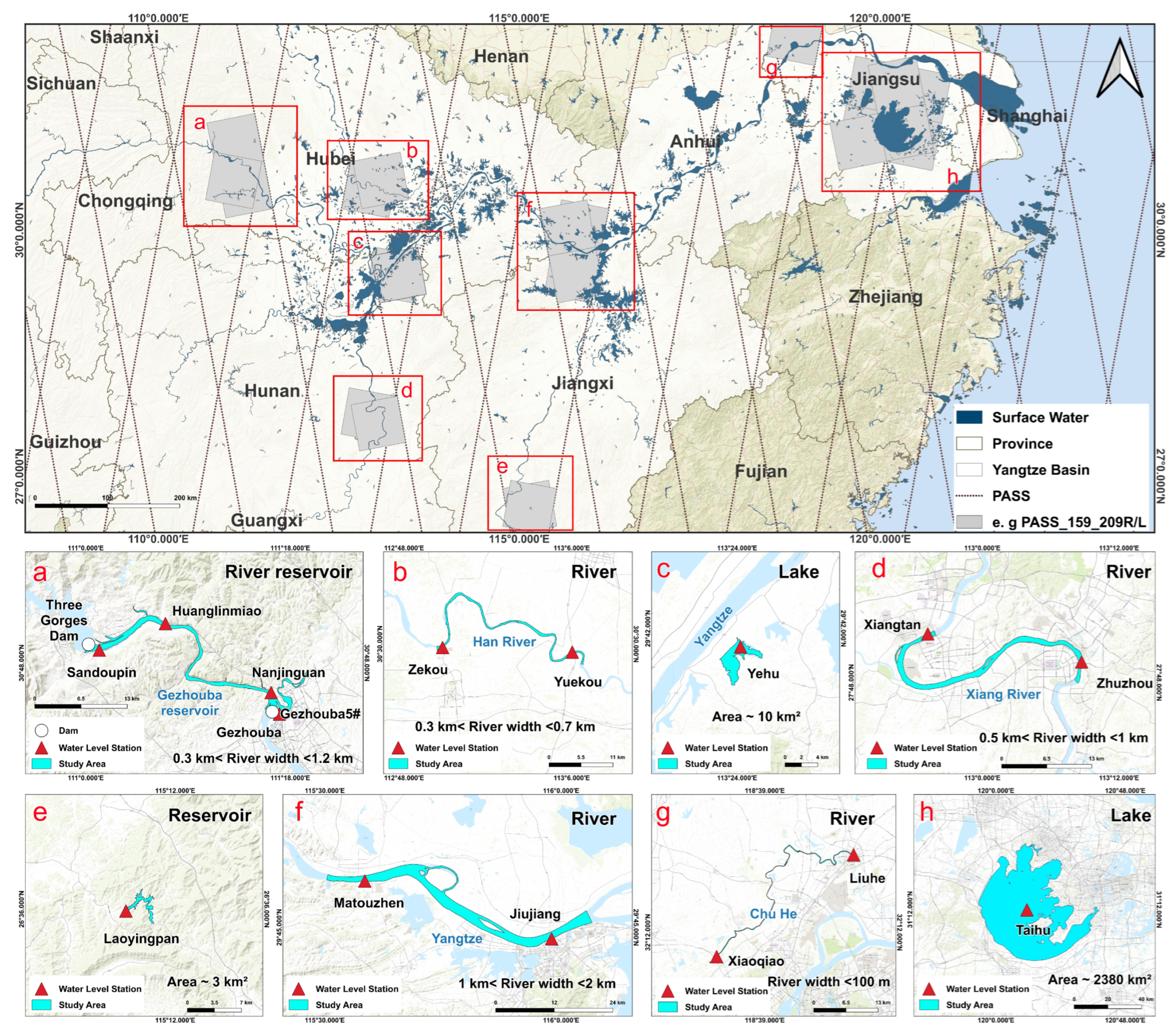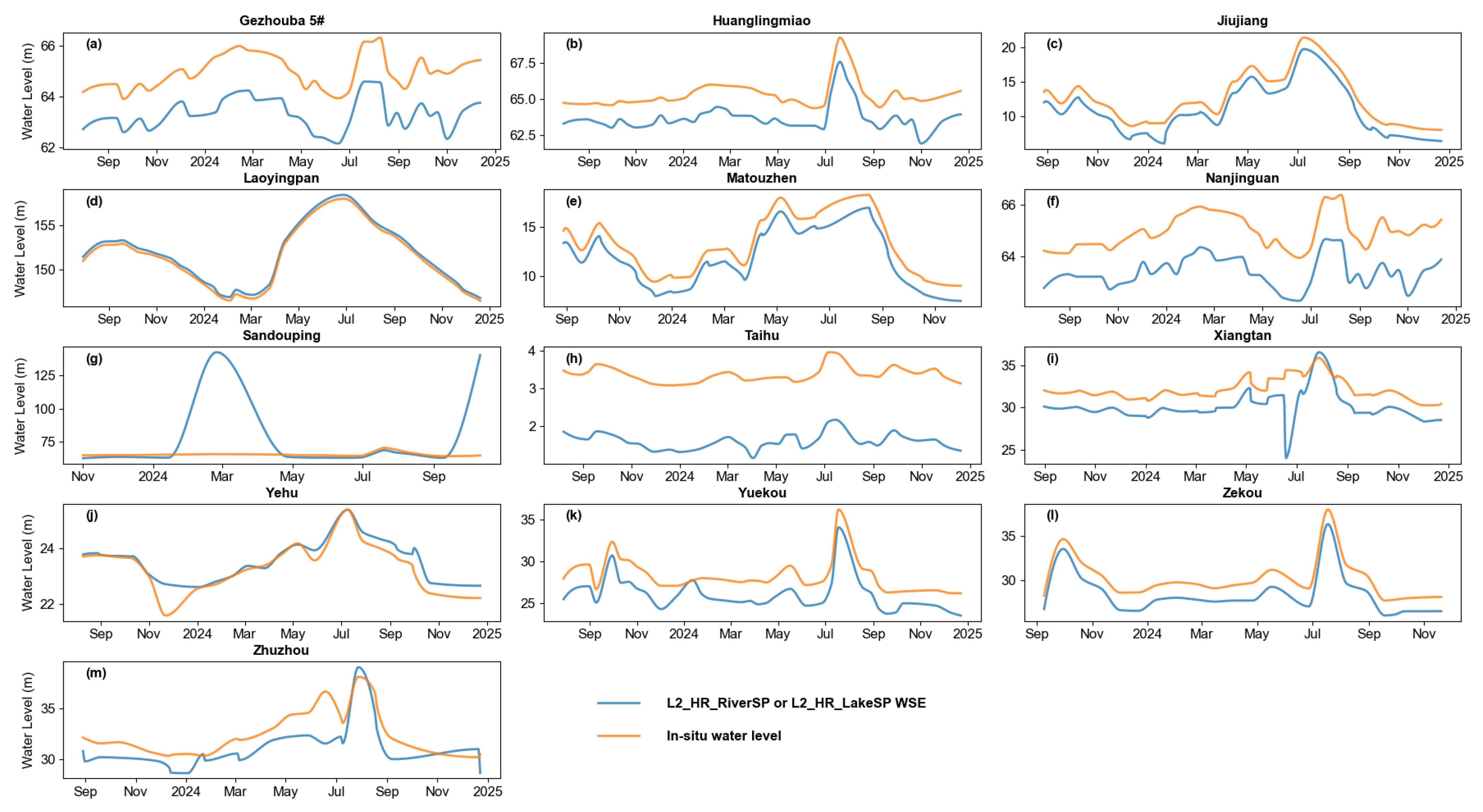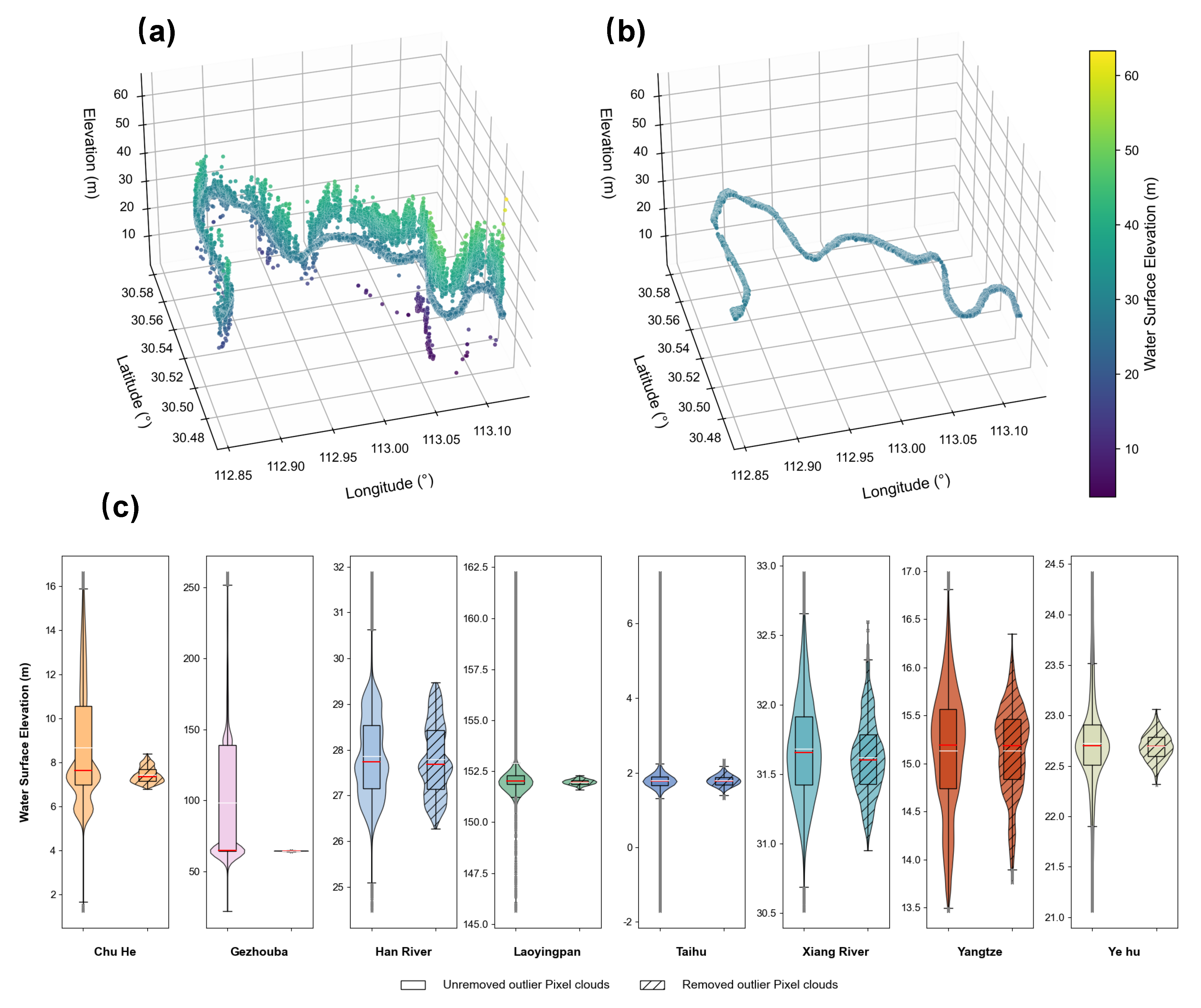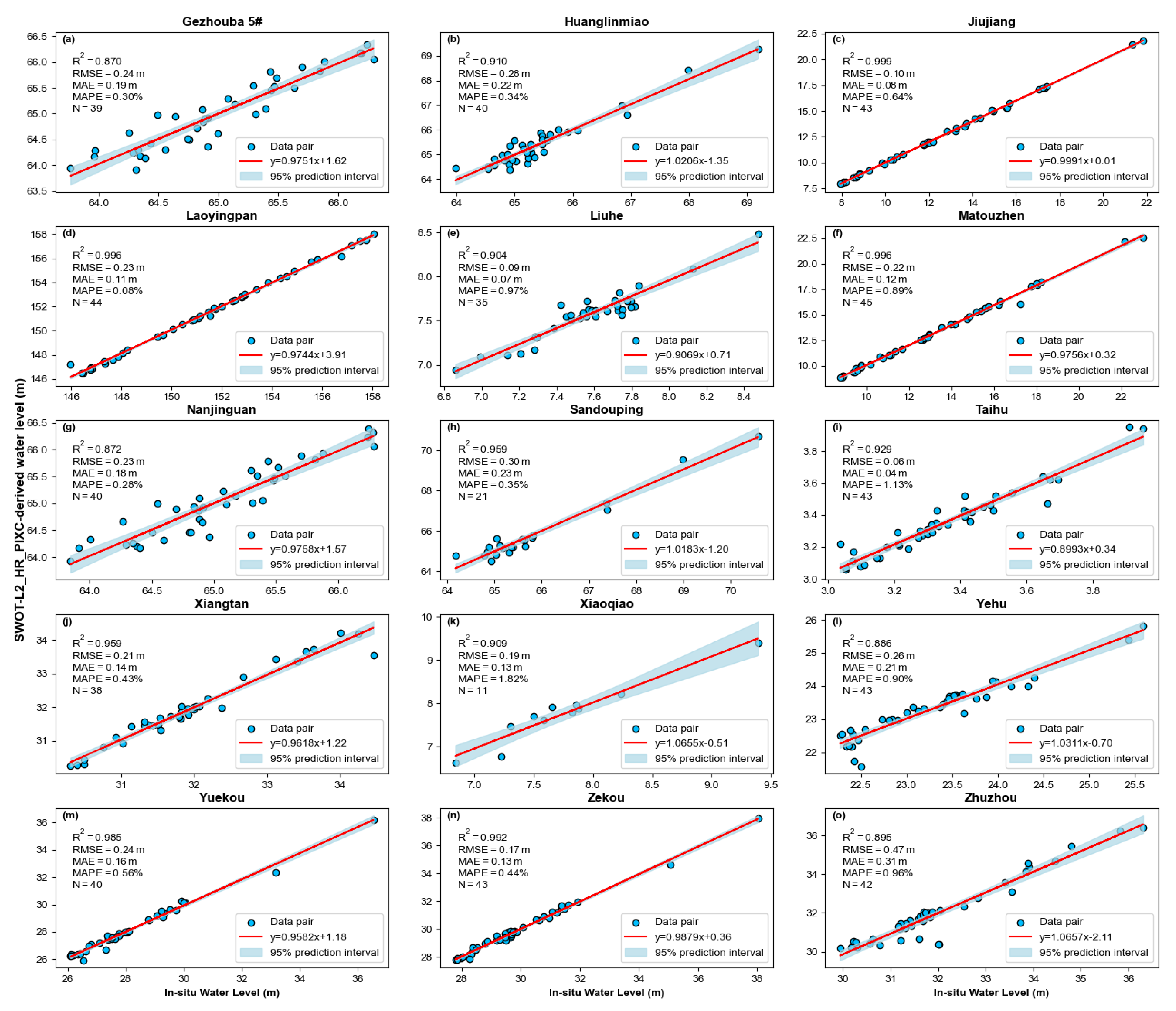Validation of Inland Water Surface Elevation from SWOT Satellite Products: A Case Study in the Middle and Lower Reaches of the Yangtze River
Abstract
1. Introduction
2. Study Area and Data
2.1. Study Area
2.2. SWOT Satellite Data
2.3. Optical and SAR Satellite Data
2.4. Other Data
3. Methods
3.1. Overall Framework
3.2. Extracting SWE
3.3. Calculation of WSE
3.4. Data Preprocessing for L2_HR_RiverSP and L2_HR_LakeSP
3.5. Noise Removal from L2_HR_PIXC
3.6. Removal of Systematic Errors
3.7. Accuracy Assessment
4. Results
4.1. Accuracy Assessment and Applicability Analysis of SWOT L2_HR_RiverSP and LakeSP Products
4.2. Accuracy Assessment and Applicability Analysis of SWOT L2_HR_PIXC
5. Discussion
5.1. Analysis of Accuracy Differences in Inland Water Level Retrieval Using the SWOT Satellites
5.2. L2_HR_PIXC Demonstrates Greater Application Potential
6. Conclusions
- (1)
- In response to spatial noise generated during the interferometric processing of the SWOT satellite, this study proposes an innovative denoising method based on the L2_HR_PIXC product, which combines multiple iterations of the IQR with the ASOR technique. Experiments in eight different regions in the middle and lower reaches of the Yangtze River show that the method can effectively remove points with uneven spatial distribution and abnormal discrete points from the pixel cloud, so that the distribution of pixel cloud elevation in each region is stable and more centralized, which significantly improves the quality of pixel cloud data.
- (2)
- Through the comprehensive analysis of the three SWOT satellite products, it is found that, compared with the two standardized derivatives, L2_HR_RiverSP and L2_HR_LakeSP, the noise-processed L2_HR_PIXC product shows higher accuracy, higher correlation coefficients, and lower errors in inland water body water level inversion. In addition, the L2_HR_PIXC data improve the temporal resolution of water level inversion to a certain extent, which makes this product more applicable in recognizing small water bodies.
- (3)
- L2_HR_RiverSP and L2_HR_LakeSP can quickly obtain hydraulic parameters of inland water bodies, which can efficiently support the analysis of water level trends in inland water bodies in a given region, basin or global scale; meanwhile, L2_HR_PIXC, with the high spatial and temporal resolution of its pixel cloud data, can completely present the two-dimensional spatial distribution characteristics of inland water bodies and effectively capture details of local spatial heterogeneity such as water level gradients, which makes it more suitable for the scientific research requiring refined data and gives it greater application potential.
Author Contributions
Funding
Data Availability Statement
Acknowledgments
Conflicts of Interest
References
- Alsdorf, D.E.; Rodríguez, E.; Lettenmaier, D.P. Measuring surface water from space. Rev. Geophys. 2007, 45, 1–24. [Google Scholar] [CrossRef]
- Sauer, V.B.; Turnipseed, D.P. Stage Measurement at Gaging Stations; Technical Report; US Geological Survey: Reston, VA, USA, 2010. [Google Scholar]
- Calmant, S.; Seyler, F. Continental surface waters from satellite altimetry. Comptes Rendus. Geosci. 2006, 338, 1113–1122. [Google Scholar] [CrossRef]
- Abdalla, S.; Kolahchi, A.A.; Ablain, M.; Adusumilli, S.; Bhowmick, S.A.; Alou-Font, E.; Amarouche, L.; Andersen, O.B.; Antich, H.; Aouf, L.; et al. Altimetry for the future: Building on 25 years of progress. Adv. Space Res. 2021, 68, 319–363. [Google Scholar] [CrossRef]
- Donlon, C.J.; Cullen, R.; Giulicchi, L.; Vuilleumier, P.; Francis, C.R.; Kuschnerus, M.; Simpson, W.; Bouridah, A.; Caleno, M.; Bertoni, R.; et al. The Copernicus Sentinel-6 mission: Enhanced continuity of satellite sea level measurements from space. Remote Sens. Environ. 2021, 258, 112395. [Google Scholar] [CrossRef]
- Kouraev, A.V.; Semovski, S.V.; Shimaraev, M.N.; Mognard, N.M.; Légresy, B.; Remy, F. Observations of Lake Baikal ice from satellite altimetry and radiometry. Remote Sens. Environ. 2007, 108, 240–253. [Google Scholar] [CrossRef]
- Guerreiro, K.; Fleury, S.; Zakharova, E.; Rémy, F.; Kouraev, A. Potential for estimation of snow depth on Arctic sea ice from CryoSat-2 and SARAL/AltiKa missions. Remote Sens. Environ. 2016, 186, 339–349. [Google Scholar] [CrossRef]
- Calmant, S.; Seyler, F.; Cretaux, J.F. Monitoring continental surface waters by satellite altimetry. Surv. Geophys. 2008, 29, 247–269. [Google Scholar] [CrossRef]
- Le Gac, S.; Boy, F.; Blumstein, D.; Lasson, L.; Picot, N. Benefits of the Open-Loop Tracking Command (OLTC): Extending conventional nadir altimetry to inland waters monitoring. Adv. Space Res. 2021, 68, 843–852. [Google Scholar] [CrossRef]
- Ryan, J.C.; Smith, L.C.; Cooley, S.W.; Pitcher, L.H.; Pavelsky, T.M. Global characterization of inland water reservoirs using ICESat-2 altimetry and climate reanalysis. Geophys. Res. Lett. 2020, 47, e2020GL088543. [Google Scholar] [CrossRef]
- Crétaux, J.F.; Birkett, C. Lake studies from satellite radar altimetry. Comptes Rendus Geosci. 2006, 338, 1098–1112. [Google Scholar] [CrossRef]
- Biancamaria, S.; Schaedele, T.; Blumstein, D.; Frappart, F.; Boy, F.; Desjonquères, J.D.; Pottier, C.; Blarel, F.; Niño, F. Validation of Jason-3 tracking modes over French rivers. Remote Sens. Environ. 2018, 209, 77–89. [Google Scholar] [CrossRef]
- Biancamaria, S.; Frappart, F.; Leleu, A.S.; Marieu, V.; Blumstein, D.; Desjonquères, J.D.; Boy, F.; Sottolichio, A.; Valle-Levinson, A. Satellite radar altimetry water elevations performance over a 200 m wide river: Evaluation over the Garonne River. Adv. Space Res. 2017, 59, 128–146. [Google Scholar] [CrossRef]
- Birkett, C.M. Contribution of the TOPEX NASA radar altimeter to the global monitoring of large rivers and wetlands. Water Resour. Res. 1998, 34, 1223–1239. [Google Scholar] [CrossRef]
- Frappart, F.; Seyler, F.; Martinez, J.M.; León, J.G.; Cazenave, A. Floodplain water storage in the Negro River basin estimated from microwave remote sensing of inundation area and water levels. Remote Sens. Environ. 2005, 99, 387–399. [Google Scholar] [CrossRef]
- Da Silva, J.S.; Calmant, S.; Seyler, F.; Rotunno Filho, O.C.; Cochonneau, G.; Mansur, W.J. Water levels in the Amazon basin derived from the ERS 2 and ENVISAT radar altimetry missions. Remote Sens. Environ. 2010, 114, 2160–2181. [Google Scholar] [CrossRef]
- Calmant, S.; Crétaux, J.F.; Rémy, F. Principles of radar satellite altimetry for application on inland waters. In Microwave Remote Sensing of Land Surface; Elsevier: Amsterdam, The Netherlands, 2016; pp. 175–218. [Google Scholar]
- Cooley, S.W.; Ryan, J.C.; Smith, L.C. Human alteration of global surface water storage variability. Nature 2021, 591, 78–81. [Google Scholar] [CrossRef]
- Brenner, A.C.; DiMarzio, J.P.; Zwally, H.J. Precision and accuracy of satellite radar and laser altimeter data over the continental ice sheets. IEEE Trans. Geosci. Remote Sens. 2007, 45, 321–331. [Google Scholar] [CrossRef]
- Fu, L.L.; Pavelsky, T.; Cretaux, J.F.; Morrow, R.; Farrar, J.T.; Vaze, P.; Sengenes, P.; Vinogradova-Shiffer, N.; Sylvestre-Baron, A.; Picot, N.; et al. The surface water and ocean topography mission: A breakthrough in radar remote sensing of the ocean and land surface water. Geophys. Res. Lett. 2024, 51, e2023GL107652. [Google Scholar] [CrossRef]
- Durand, M.; Fu, L.L.; Lettenmaier, D.P.; Alsdorf, D.E.; Rodriguez, E.; Esteban-Fernandez, D. The surface water and ocean topography mission: Observing terrestrial surface water and oceanic submesoscale eddies. Proc. IEEE 2010, 98, 766–779. [Google Scholar] [CrossRef]
- Frasson, R.P.d.M.; Schumann, G.J.P.; Kettner, A.J.; Brakenridge, G.R.; Krajewski, W.F. Will the surface water and ocean topography (SWOT) satellite mission observe floods? Geophys. Res. Lett. 2019, 46, 10435–10445. [Google Scholar] [CrossRef]
- Jinghua, X.; Shenglian, G.; Liguang, J.; Jiabo, Y.; Jun, W. Exploring the potential of SWOT for water level monitoring in the Qinghai Lake. Natl. Remote Sens. Bull. 2023, 27, 1888–1898. [Google Scholar]
- Grippa, M.; Rouzies, C.; Biancamaria, S.; Blumstein, D.; Cretaux, J.F.; Gal, L.; Robert, E.; Gosset, M.; Kergoat, L. Potential of SWOT for monitoring water volumes in Sahelian ponds and lakes. IEEE J. Sel. Top. Appl. Earth Obs. Remote Sens. 2019, 12, 2541–2549. [Google Scholar]
- Nair, A.S.; Soman, M.K.; Girish, P.; Karmakar, S.; Indu, J. Evaluating SWOT water level information using a large scale hydrology simulator: A case study over India. Adv. Space Res. 2022, 70, 1362–1374. [Google Scholar] [CrossRef]
- Elmer, N.J.; Hain, C.; Hossain, F.; Desroches, D.; Pottier, C. Generating proxy SWOT water surface elevations using WRF-Hydro and the CNES SWOT Hydrology Simulator. Water Resour. Res. 2020, 56, e2020WR027464. [Google Scholar]
- Jet Propulsion Laboratory. SWOT Product Description Document: Level 2 KaRIn High Rate Water Mask Pixel Cloud (L2_HR_PIXC) Data Product; Internal Document JPL D-56411, Revision B; Jet Propulsion Laboratory: Pasadena, CA, USA, 2023. [Google Scholar]
- Jet Propulsion Laboratory. SWOT Product Description Document: Level 2 KaRIn High Rate River Single Pass Vector (L2_HR_RiverSP) Data Product; Internal Document JPL D-56413, Revision B; Jet Propulsion Laboratory: Pasadena, CA, USA, 2023. [Google Scholar]
- Centre National d’Études Spatiales. SWOT Product Description Document: Level 2 KaRIn High Rate Lake Single Pass Vector Product (L2_HR_LakeSP); Internal Document SWOT-TN-CDM-0673-CNES, Revision C (Draft); Centre National d’Études Spatiales: Paris, France, 2024. [Google Scholar]
- Xu, Y.; Liu, W.; Song, J.; Yao, L.; Gu, S. Dynamic monitoring of the lake area in the middle and lower reaches of the Yangtze River using MODIS images between 2000 and 2016. IEEE J. Sel. Top. Appl. Earth Obs. Remote Sens. 2018, 11, 4690–4700. [Google Scholar] [CrossRef]
- Qi, Z.; Ye, Y.; Sun, L.; Yuan, C.; Cai, Y.; Xie, Y.; Cheng, G.; Zhang, P. Development of an indicator system for solar-induced chlorophyll fluorescence monitoring to enhance early warning of flash drought. Agric. Water Manag. 2025, 312, 109397. [Google Scholar]
- Qi, Z.; Ye, Y.; Cai, Y.; Yuan, C.; Xie, Y.; Cheng, G.; Zhang, P.; Sun, L.; Wan, H. Investigating the characteristics and drivers of slow droughts and flash droughts: A multi-temporal scale drought identification framework. Water Resour. Res. 2025, 61, e2024WR037181. [Google Scholar]
- Qi, Z.; Ye, Y.; Cai, Y.; Yuan, C.; Xie, Y.; Cheng, G.; Zhang, P.; Sun, L. Incorporation crisis lifecycle theory into full-stage flash drought spatio-temporal pattern identification and risk analysis. J. Hydrol. 2024, 642, 131828. [Google Scholar]
- Jet Propulsion Laboratory. SWOT Algorithm Theoretical Basis Document: Level 2 KaRIn High Rate Pixel Cloud (L2_HR_PIXC) Science Algorithm Software; Internal Document JPL D-105504; Jet Propulsion Laboratory: Pasadena, CA, USA, 2023. [Google Scholar]
- Altenau, E.H.; Pavelsky, T.M.; Durand, M.T.; Yang, X.; Frasson, R.P.d.M.; Bendezu, L. The Surface Water and Ocean Topography (SWOT) Mission River Database (SWORD): A global river network for satellite data products. Water Resour. Res. 2021, 57, e2021WR030054. [Google Scholar]
- Wang, J.; Pottier, C.; Cazals, C.; Battude, M.; Sheng, Y.; Song, C.; Sikder, M.S.; Yang, X.; Ke, L.; Gosset, M.; et al. The Surface Water and Ocean Topography Mission (SWOT) Prior Lake Database (PLD): Lake mask and operational auxiliaries. Authorea 2023, 279, 778–780. [Google Scholar]
- Jet Propulsion Laboratory. SWOT Algorithm Theoretical Basis Document: Level 2 KaRIn High Rate River Single Pass (L2_HR_RiverSP) Science Algorithm Software; Internal Document JPL D-105505; Jet Propulsion Laboratory: Pasadena, CA, USA, 2023. [Google Scholar]
- Gorelick, N.; Hancher, M.; Dixon, M.; Ilyushchenko, S.; Thau, D.; Moore, R. Google Earth Engine: Planetary-scale geospatial analysis for everyone. Remote Sens. Environ. 2017, 202, 18–27. [Google Scholar] [CrossRef]
- Jiang, W.; Kong, F.; Ding, X.; Luo, G.; Pang, Z. Water Quality Monitoring of Inland Waters Using Remote Sensing Based on GEE and Sentinel-2 Imagery. In Proceedings of the 15th International Conference on Hydroinformatics, Beijing, China, 27–31 May 2024; p. 52. [Google Scholar]
- Lehner, B.; Beames, P.; Mulligan, M.; Zarfl, C.; De Felice, L.; van Soesbergen, A.; Thieme, M.; Garcia de Leaniz, C.; Anand, M.; Belletti, B.; et al. The Global Dam Watch database of river barrier and reservoir information for large-scale applications. Sci. Data 2024, 11, 1069. [Google Scholar] [CrossRef] [PubMed]
- Wang, Y.; Long, D.; Li, X. High-temporal-resolution monitoring of reservoir water storage of the Lancang-Mekong River. Remote Sens. Environ. 2023, 292, 113575. [Google Scholar] [CrossRef]
- Pekel, J.F.; Cottam, A.; Gorelick, N.; Belward, A.S. High-resolution mapping of global surface water and its long-term changes. Nature 2016, 540, 418–422. [Google Scholar] [CrossRef]
- Yommy, A.S.; Liu, R.; Wu, S. SAR image despeckling using refined Lee filter. In Proceedings of the 2015 7th International Conference on Intelligent Human-Machine Systems and Cybernetics, Hangzhou, China, 26–27 August 2015; IEEE: Piscataway, NJ, USA, 2015; Volume 2, pp. 260–265. [Google Scholar]
- Jia, S.; Xue, D.; Li, C.; Zheng, J.; Li, W. Study on new method for water area information extraction based on Sentinel-1 data. Yangtze River 2019, 50, 213–217. [Google Scholar]
- Feyisa, G.L.; Meilby, H.; Fensholt, R.; Proud, S.R. Automated Water Extraction Index: A new technique for surface water mapping using Landsat imagery. Remote Sens. Environ. 2014, 140, 23–35. [Google Scholar] [CrossRef]
- Otsu, N. A threshold selection method from gray-level histograms. Automatica 1975, 11, 23–27. [Google Scholar] [CrossRef]
- Jet Propulsion Laboratory. SWOT Science Data Products User Handbook; Internal Document JPL D-109532; Jet Propulsion Laboratory: Pasadena, CA, USA, 2024. [Google Scholar]
- Yu, L.; Zhang, H.; Gong, W.; Ma, X. Validation of Mainland Water Level Elevation Products From SWOT Satellite. IEEE J. Sel. Top. Appl. Earth Obs. Remote Sens. 2024, 17, 13494–13505. [Google Scholar] [CrossRef]
- Vinogradova, N.T.; Pavelsky, T.M.; Farrar, J.T.; Hossain, F.; Fu, L.L. A new look at Earth’s water and energy with SWOT. Nat. Water 2025, 3, 27–37. [Google Scholar] [CrossRef]
- Getirana, A.; Kumar, S.; Bates, P.; Boone, A.; Lettenmaier, D.; Munier, S. The SWOT mission will reshape our understanding of the global terrestrial water cycle. Nat. Water 2024, 2, 1139–1142. [Google Scholar] [CrossRef]
- Yao, J.; Xu, N.; Wang, M.; Gong, P.; Lu, H.; Cao, Y.; Tang, X.; Mo, F. Promoting global surface water monitoring research with the SWOT satellite. Innov. Geosci. 2024, 2, 100099. [Google Scholar] [CrossRef]
- Patidar, G.; Paris, A.; Indu, J.; Karmakar, S. How can SWOT derived water surface elevations help calibrating a distributed hydrological model? J. Hydrol. 2025, 56, 132968. [Google Scholar] [CrossRef]
- Yoon, Y.; Durand, M.; Merry, C.J.; Rodriguez, E. Improving temporal coverage of the SWOT mission using spatiotemporal kriging. IEEE J. Sel. Top. Appl. Earth Obs. Remote Sens. 2013, 6, 1719–1729. [Google Scholar] [CrossRef]






| Level | Product | Sub-Product | Format | Description |
|---|---|---|---|---|
| L2 | L2_HR_PIXC | —— | NetCDF | Water mask pixel cloud dataset containing geolocated heights, classification parameters, backscatter coefficients, geophysical fields, and quality flags |
| L2_HR_RiverSP | Node | Shapefile | Nodes spaced approximately 200 m apart, extracted from the SWOT River Database (SWORD_V16) | |
| Reach | Shapefile | River reaches (∼10 km segments) derived from the SWORD_V16 database; [35] | ||
| Obs | Shapefile | Lakes that are both included in the Prior Lake Database (PLD) [36] and observed by the SWOT satellite | ||
| L2_HR_LakeSP | Prior | Shapefile | Composite lakes inventory encompassing PLD-archived and SWOT-observed waterbodies, with null values assigned to PLD lakes lacking SWOT observations | |
| Unassigned | Shapefile | SWOT-observed lakes unrecorded in the PLD database |
| Dataset | Variable | Spatial Resolution | Temporal Resolution | Time Span | Purpose | Data Source |
|---|---|---|---|---|---|---|
| SWOT | L2_HR_PIXC | 50 m | 21 days | 2023.08-2024.12 | WSE retrieval | NASA |
| SWOT | L2_HR_RiverSP | – | 21 days | 2023.08-2024.12 | WSE retrieval | NASA |
| SWOT | L2_HR_LakeSP | – | 21 days | 2023.08-2024.12 | WSE retrieval | NASA |
| Sentinel-1A | VV/VH | 10 m | 12 days | 2023.08-2024.12 | SWE retrieval | GEE |
| Sentinel-2 | TOA reflectance | 10 m | 5 days | 2023.08-2024.12 | SWE retrieval | GEE |
| GDW-V1 | Vector boundaries | – | – | 2024 | SWE retrieval | GDW |
| In situ water level | Water level | – | 1 day | 2023.08–2024.12 | Water level validation | In situ stations |
| Study Area | In Situ Station | L2_HR_RiverSP/L2_HR_LakeSP | L2_HR_PIXC | ||||||||
|---|---|---|---|---|---|---|---|---|---|---|---|
| RMSE | MAE | MAPE | Number | RMSE | MAE | MAPE | Number | ||||
| Gezhouba | Gezhouba 5# | 0.815 | 0.29 | 0.22 | 0.34 | 34 | 0.870 | 0.24 | 0.19 | 0.30 | 39 |
| Huanglinmiao | 0.887 | 0.33 | 0.23 | 0.36 | 38 | 0.910 | 0.28 | 0.22 | 0.34 | 40 | |
| Nanjinguan | 0.779 | 0.30 | 0.22 | 0.34 | 37 | 0.872 | 0.23 | 0.18 | 0.28 | 40 | |
| Sandoupoing | −0.612 | 33.03 | 20.11 | 18.82 | 15 | 0.959 | 0.30 | 0.23 | 0.35 | 21 | |
| Yangtze | Matouzhen | 0.997 | 0.16 | 0.12 | 0.99 | 35 | 0.996 | 0.22 | 0.12 | 0.89 | 45 |
| Jiujiang | 0.994 | 0.24 | 0.13 | 1.33 | 38 | 0.999 | 0.10 | 0.08 | 0.64 | 43 | |
| Xiang River | Xiangtan | 0.336 | 1.45 | 0.50 | 1.67 | 37 | 0.959 | 0.21 | 0.14 | 0.43 | 38 |
| Zhuzhou | 0.709 | 1.18 | 0.78 | 2.33 | 24 | 0.895 | 0.47 | 0.31 | 0.96 | 42 | |
| Chuhe | Xiaoqiao | — | — | — | — | — | 0.909 | 0.19 | 0.13 | 1.82 | 11 |
| Liuhe | — | — | — | — | — | 0.904 | 0.09 | 0.07 | 0.97 | 35 | |
| Han River | Yuekou | 0.923 | 0.56 | 0.39 | 1.37 | 33 | 0.985 | 0.24 | 0.16 | 0.56 | 40 |
| Zekou | 0.991 | 0.23 | 0.18 | 0.60 | 21 | 0.992 | 0.17 | 0.13 | 0.44 | 43 | |
| Yehu | Yehu | 0.814 | 0.28 | 0.22 | 0.94 | 26 | 0.886 | 0.26 | 0.21 | 0.9 | 43 |
| Laoyingpan | Laoyingpan | 0.999 | 0.07 | 0.06 | 0.04 | 34 | 0.996 | 0.23 | 0.11 | 0.08 | 44 |
| Taihu | Taihu | 0.778 | 0.10 | 0.06 | 1.67 | 36 | 0.929 | 0.06 | 0.04 | 1.13 | 43 |
Disclaimer/Publisher’s Note: The statements, opinions and data contained in all publications are solely those of the individual author(s) and contributor(s) and not of MDPI and/or the editor(s). MDPI and/or the editor(s) disclaim responsibility for any injury to people or property resulting from any ideas, methods, instructions or products referred to in the content. |
© 2025 by the authors. Licensee MDPI, Basel, Switzerland. This article is an open access article distributed under the terms and conditions of the Creative Commons Attribution (CC BY) license (https://creativecommons.org/licenses/by/4.0/).
Share and Cite
Zhao, Y.; Fu, J.; Pang, Z.; Jiang, W.; Zhang, P.; Qi, Z. Validation of Inland Water Surface Elevation from SWOT Satellite Products: A Case Study in the Middle and Lower Reaches of the Yangtze River. Remote Sens. 2025, 17, 1330. https://doi.org/10.3390/rs17081330
Zhao Y, Fu J, Pang Z, Jiang W, Zhang P, Qi Z. Validation of Inland Water Surface Elevation from SWOT Satellite Products: A Case Study in the Middle and Lower Reaches of the Yangtze River. Remote Sensing. 2025; 17(8):1330. https://doi.org/10.3390/rs17081330
Chicago/Turabian StyleZhao, Yao, Jun’e Fu, Zhiguo Pang, Wei Jiang, Pengjie Zhang, and Zixuan Qi. 2025. "Validation of Inland Water Surface Elevation from SWOT Satellite Products: A Case Study in the Middle and Lower Reaches of the Yangtze River" Remote Sensing 17, no. 8: 1330. https://doi.org/10.3390/rs17081330
APA StyleZhao, Y., Fu, J., Pang, Z., Jiang, W., Zhang, P., & Qi, Z. (2025). Validation of Inland Water Surface Elevation from SWOT Satellite Products: A Case Study in the Middle and Lower Reaches of the Yangtze River. Remote Sensing, 17(8), 1330. https://doi.org/10.3390/rs17081330








